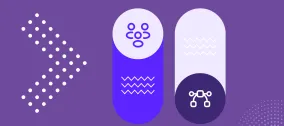Going Beyond the Standards of Accessibility for Your Higher Ed Website
Authored by: Bjorn Thomson & Laura Ballay
The majority of higher ed organizations mandate that websites comply with a given standard such as WGAC AA 2.1. But ensuring sites are truly accessible can be daunting. How do you know when a site is actually accessible?
There’s no shortage of information, recommendations, and benchmarks available. Any quick Google search into “accessibility” will produce more results than you have time or energy to sift through. Accessibility checkers such as Siteimprove and WAVE are also readily available and certainly help. But when it comes to reaching accessibility that goes beyond “checking the boxes” in Siteimprove and instead ensures all users have a positive, engaging experience, where can you turn?
Providing a good user experience to those with a disability often requires you to think holistically about your content and design and how users actually experience it. Luckily, with the capabilities of web design continually evolving, the ways in which to improve accessibility are evolving, too. What you find out might not surprise you, though, because you already have what you need: The personnel who will provide you the insight to enrich your user experience.
Considerations for a Meaningful Web Environment Experience for Your Users
There are a couple of main drivers for creating an accessible site, especially for higher ed institutions. One is obvious: compliance. No one wants to be audited, sued, and found to be in violation of accessibility standards. The outcome of this is never good. Another is the business case. After all, many improvements to accessibility improve both SEO and user experience overall and are recommended by Google and SEO experts.
But perhaps the most salient is this: Your higher education institution cares about having a welcoming, inclusive environment where people feel that everybody is considered, and this goes beyond compliance. Accessibility naturally flows into inclusivity and universal design, which all form the heart of human-centered design. Designing for a range of user needs, including those with cognitive impairment, blindness, the hardness of hearing, or other disabilities, demonstrates that diversity is recognized and valued. Many accessibility projects tend to focus on issues that can be checked with software. Things that are easy to automate and test. But what about the subjective experience of the user, and their wide spectrum of needs? That’s something software can’t detect. Yet, many essential accessibility issues can only be addressed by applying human-centered design principles.
For example, content that is succinct and ‘front-loads’ the key links and information are hugely beneficial to not only users with disabilities but for all audiences as it demonstrates content strategy best practices. Similarly, meaningful link text or ‘alt’ image tags are critical dimensions of accessibility but require human judgment to assess. Content strategy, page design, and navigation must take into consideration the needs of diverse users and speak and appeal to them. And those things can’t be automated.
Compliance is an important element of accessibility but it doesn’t answer the question, “what does the user think about this?” or “how does this work for them?” In order to make the web experience worth it — and meaningful — for diverse audiences, you have to put yourself in their proverbial shoes. Better yet, invite them to participate in your design and testing. What better way to know you are doing all that you can to make sure your accessibility is going above and beyond?
Accessibility Standards Include More Than You Think
Unfortunately, accessibility requirements only tend to focus on a narrow range of disabilities, namely visual and motor impairments. But in order for your site to be genuinely universally accessible, you’ll need to broaden your design and consider beyond the needs of “average” or “typical” users.
According to the Americans with Disabilities Act, the list of disabilities encompasses the following:
- Vision
- Mobility
- Auditory
- Neurological
- Cognitive
- Medical
- Psychological
You may not have known the list includes some of these disabilities. But now that you do, you can work to expand your reach and acknowledge the users with disabilities beyond what is normally considered. But this list isn’t exhaustive. Yes, there’s more.
Older users, users in rural areas, and developing countries should also be considered in accessibility design, though they aren’t thought of as “disabled.” But an often unacknowledged fact is that Section 508 also covers social inclusion — not just persons with a disability. W3C re: inclusion considers a broad range of diversity, including:
- Accessibility for people with disabilities;
- Access to and quality of hardware, software, and internet connectivity;
- Computer literacy and skills;
- Economic situation;
- Education;
- Geographic location;
- Culture;
- Age, including older and younger people;
- Language.
Don’t worry. It’s common to only think of accessibility in terms of those oft-visible disabilities. But now you realize that there’s more work to be done in this space.
You can be on the lookout for this segment of your audience, and be at the forefront of inclusion for these people who aren’t often thought of. Designing your web environment with a broader pool of users in mind (beyond the standard narrow view) opens the way for deeper engagement.
It’s Time to Invite Users to the Web Designing and Testing Process
When you last designed your website and tested for accessibility, who was included? What stakeholders were there to make sure everything looked and functioned as it should? If you didn’t include disabled users in your usability testing, you have an opportunity, and obligation going forward. Projects are greatly enhanced by collecting feedback directly from disabled users, as well as including them in your usability testing.
Your empathy is important but for a quality web design process, it’s going to be necessary to engage disabled users. They will provide insights that non-disabled users simply can’t. Work toward creating pre-vetted, accessible UI design patterns that content editors can use as templates. If you don’t know where to start with finding your users, check with your office that focuses on diversity and inclusion.
Invite these critical stakeholders into your process, and you’ll discover an enriching experience — for everyone involved. The time you spend learning from those whom you’re ultimately serving will save you time in the long run, teach you some new things, and guarantee you’re doing all you can to make a better UX for all of your users.







